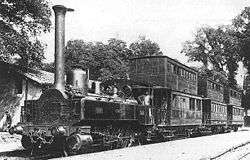Anatole Mallet


Jules T. Anatole Mallet (23 May 1837 – 10 October 1919) was a Swiss mechanical engineer, who was the inventor of the first successful compound system for a railway steam locomotive, patented in 1874.[1]
In 1876 he introduced a series of small 2-cylinder compound 0-4-2 tank locomotives for the Bayonne-Anglet-Biarritz Railway in France. He subsequently designed an articulated compound system with a rigid chassis at the rear carrying two high-pressure cylinders plus two low-pressure ones mounted on an articulated front driving truck, patented in 1884[1] with full rights granted in 1885.[2] This was first used for a series of 600 mm (1 ft 11 5⁄8 in) narrow gauge locomotives specially built by the Decauville Company in 1888 for the Paris Exposition of 1889.[2] This arrangement became known as the Mallet locomotive.
He was awarded the Elliott Cresson Medal of The Franklin Institute in 1908.
See also
References
- 1 2 Ransome-Wallis, P. (1959). Illustrated Encyclopedia of World Railway Locomotives (2001 republication ed.). Dover Publications, Inc. pp. 500–501. ISBN 0-486-41247-4.
- 1 2 Durrant, A. E. (1974). The Mallet Locomotive. Newton Abbot: David & Charles. ISBN 0-7153-5904-5.
External links
- There is a relevant English-language forum at Railways of Germany